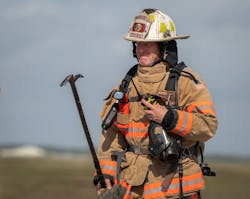It seems safe to say that almost everyone knows what it’s like to have a bad boss, a person who’s at the head of an organization or section who seems to lack the qualities and abilities to lead the business and the people.
Luckily, some of us also had the pleasure to work for a great boss, a person who truly knows how to develop a group into a team, opportunities into successes and individuals into leaders.
What separates a bad boss from a good boss? Although this is a question that’s been looked at from many different angles, the degree to which someone who’s in a leadership role is passive or active might well be the single most telling sign of the quality of leadership, particularly in the fire service.
Decisive leadership
There are numerous definitions of the word “leadership.” The one that I like the best is, “Leadership is a process of social influence, which maximizes the efforts of others, toward the achievement of a goal.” Using this definition, we can see that it’s an individual’s influence, not authority, that’s the primary motivator for followers. Also, the definition is directed at a goal—leaders must know where they want to go. This is an important distinction that helps to identify a true leader.
In the fire service, what are the more specific attributes of a leader? We could list several to describe the ideal chief officer or captain: Decisive yet collaborative, experienced yet open-minded, empathetic and humble might be at the top of many lists. As it applies to active versus passive leadership, aside from “experienced,” these phrases are all decisions. One decides to be decisive, open-minded and humble, although it might take practice, and no one is ever perfect. Conversely, the passive leader instinctively might decide to be reactive, uncaring and self-focused, because, many times, these are easy roads to take. Therefore, decisiveness might be the single most impactful quality in a fire service leader.
Progression vs. status quo
A famous maxim says that the fire service is 200 years of tradition unimpeded by progress. Although we clearly progressed in countless ways over the years, many firefighters do seem to hold to the status quo as the default stance.
Departments usually don’t produce a product, and our service is somewhat difficult to quantify in terms of success. This might be a reason passive leaders often lean on a static position when they consider whether organizational change is necessary—maintain course, simply because no one has died yet or no other clearly negative effect has resulted.
Progress doesn’t have to be about change just for change’s sake though. When active leaders consider the organization’s goals formulated with stakeholders’ input and the leader’s long-term vision in mind, they can make very timely, well-informed and well-defined decisions to help to guide the department to achieve those goals.
Active leaders consider the benefits and costs as well as direct and indirect effects of a decision before they jump into the newest fad or gizmo—but then they will act.
Passive leaders delay a decision and allow the analysis of every variable and what-if scenario to spiral into nonaction, letting the potential win for the department or community die on the vine. At this point, it might be clear that, sometimes, passive leaders truly end up doing more work than active leaders. They take more action to fight a changing tide, which often is the natural flow of where the organization must go.
Tradition often is cited as a justification to buck against progress. Make no mistake, fire service traditions are something to be proud of. We should honor them, just as we honor the generations of firefighters who served previously.
Tradition also can be used as a rock to hide behind to avoid making difficult decisions.
Active, invested leaders learn how to balance tradition with necessary progression. Think of the many ways that we developed tactics and equipment over time to improve both firefighter and victim safety. Many of those changes directly challenged what, at the time, might have been considered an ingrained part of the job. Take the advent of the SCBA for the smoke-eating generation: It first was brought to the fire service in the mid-1940s, but it wasn’t adopted widely until decades later. Active leaders can use this as a good example of how to apply progressive ideas to traditional situations: Add a piece of equipment that makes the team safer and see that this lets us double down on aggressive firefighting (what we really want to be doing).
Saying ‘no’
We aren’t advocating for leaders who give a blanket “yes” and let every idea that’s floated see prime time. Some ideas don’t fit into a department’s vision or are fundamentally flawed for reasons that, perhaps, the member who pitched it didn’t fully understand. In this case, we would say that this responsibility still is squarely in the leader’s job jar. It’s active leaders’ responsibility to share the department’s vision and, to the best of their ability, be transparent with as many of the department’s “whys” as possible. Then, if armed with that information, the no-go pitch still makes its way to the decision-makers, then it’s leaders’ responsibility to deliver the clear “no” or “not right now” along with a good reason why. When the “why” is left out of the “no,” the leaders failed and should expect no improvement in the quality or maturity of the ideas that are floated to their level.
What we as leaders say no to is just as important as the things we say yes to—but we must make both count.
For the leaders at every level
- Build a close circle of trusted advisors, including ones who will tell you when you are wrong.
- Discuss, debate and take action on the important stuff. Don’t waste loads of time on the daily thrash.
- Make the easy and the difficult decisions—and do it in a timely fashion.
- Don’t become paralyzed when you don’t know what to do. Get smart by asking those who know about the subject, then act.
- Do only what only you can do. Empower your team to handle the rest.
- Make your time impactful—for you and others.
- Wholeheartedly believe in your organization’s mission, vision and values. If you don’t, your followers won’t either.
For the change-agents
- Don’t underestimate your importance and effect on the organization. Your bosses and the employees both need you.
- Don’t overestimate your importance and effect on the organization; your bosses make the decisions. You’re the advocate and voice for the plan.
- Don’t be afraid to refine and re-pitch if you were told “no”—but make sure that you actually improved using the good feedback that the leaders should be giving you. Fight for feedback!
For the followers
- Your importance can’t be overstated: A leader without followers is an individual who is going nowhere.
- Use your change-agents (formal and informal) to help to develop your ideas and feedback into tangible, practical and actionable pitches for the decision-makers to consider; in other words, don’t shoot from the hip and hope for good results.
- In situations in which you were given the delegated power to make decisions, lead! In situations in which you weren’t delegated power, follow!
Photo by U.S. Air Force/Samuel King Jr. The appearance of U.S. Department of Defense (DoD) visual information does not imply or constitute DoD endorsement.
About the Author

Ben Perry
Ben Perry is an active-duty senior noncommissioned officer in the U.S. Air Force who is stationed in San Antonio, TX. He is a CFO and deputy fire chief who has more than 16 years in public safety. Perry also is the co-founder and host of The FireDawg Podcast (firedawg.us), which publishes podcast episodes and other content for the fire protection community.
